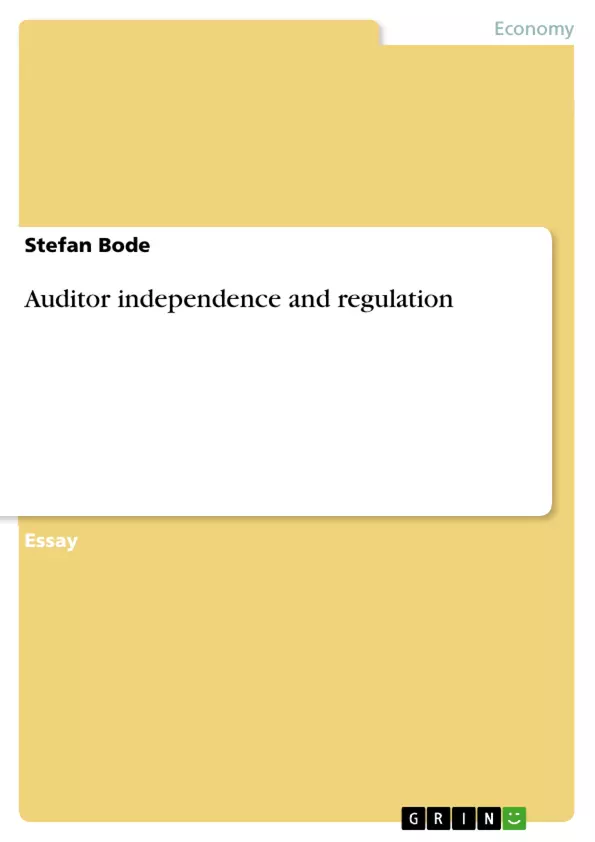This essay is concerned with the pros and cons of auditor independence and describes the way to the current audit regulation.
The editor specifies five major threats which could jeopardise auditor independence. If auditors have any financial or personal interests in their clients then the self-interest threat, the self-review threat, the advocacy threat, the familiarity threat and finally the intimidation threat may occur. The intimidation threat is stressed as the most important one: as auditors highly rely on companies’ directors. They have the power to interfere with auditors’ work and can cease all lucrative non-audit service contracts if auditors do not agree with their view. Moreover, auditors’ remuneration is determined and auditors are appointed by them in reality.
Furthermore, it is emphasised that especially in recent times some safeguards have been implemented by the profession, regulation, within the assurance clients and within auditing firms to eliminate the above-mentioned threats. Within the assurance client introduced independent audit committees are widespread. Further, auditing firms have implemented their own more narrowly prescribed ethical standards. Beyond this, it is highlighted that legislation is of paramount importance. The Companies Act 1985, 1989, 2004 and above all the ISA were enacted to enhance auditor independence.
The third section commences by describing the past of audit regulation. It is explained that in response to the growing public criticism in the 1960s and 1970s the professional accountancy bodies began slowly to introduce auditing standards, ethical codes, disciplinary, licensing and monitoring arrangements. Further, in the aftermath of the demise of many large companies in the 1980s, the government started to implement a new regulatory framework to reduce auditors’ failures. The Companies Act 1989 and the implemented ISA in 2004 are results of the entry into the EU, as the UK must adopt EU legislation.
It is estimated that in the near future the professions’ self-regulation may be abolished and stricter rules regarding audit liabilities will be implemented.
This essay concludes by stating that the current situation may upset all stakeholders as unbiased auditors are not guaranteed by the self-regulated profession. The fact that audit is a business may contradict it, too. Nevertheless, it is mentioned that auditors, who act dependently are a tiny minority in reality.
Inhaltsverzeichnis (Table of Contents)
- 1. Introduction...
- 2. Auditor independence....
- 2.1 Arguments against auditor independence.....
- 2.2 Arguments for auditor independence.......
- 3. Auditor Regulation....
- 3.1 Pre-1980s period....
- 3.2 Post-1980s period......
- 3.3 View into the future.....
- 4. Conclusion...
Zielsetzung und Themenschwerpunkte (Objectives and Key Themes)
This essay critically examines the concept of auditor independence and the evolution of audit regulation. It investigates the arguments for and against auditor independence, analyzes the historical development of audit regulation, and speculates about future trends in the field.
- Auditor independence and its threats
- The impact of non-audit services on auditor independence
- Historical evolution of audit regulation
- Current and future trends in audit regulation
- The role of professional bodies and government in regulating the audit profession
Zusammenfassung der Kapitel (Chapter Summaries)
The essay begins by exploring the complexities of auditor independence, examining arguments both for and against its existence. It identifies several threats to auditor independence, such as financial and personal interests, self-review, advocacy, familiarity, and intimidation. The intimidation threat is highlighted as particularly significant due to the power dynamics between auditors and company directors.
The subsequent section dives into the historical development of audit regulation. The essay traces the evolution of regulation from the pre-1980s period, marked by the emergence of auditing standards, ethical codes, and disciplinary measures, to the post-1980s era, where the government took a more active role in implementing a regulatory framework to address auditor failures. The essay argues that the profession has historically been self-regulated, with professional bodies playing a central role in creating and implementing legislation.
The final section looks toward the future of audit regulation, speculating on potential developments such as the abolition of self-regulation, stricter rules regarding audit liabilities, and the promotion of competition within the audit business.
Schlüsselwörter (Keywords)
The central themes of this essay revolve around auditor independence, audit regulation, professional ethics, self-regulation, government regulation, non-audit services, and the impact of financial reporting on stakeholders. It examines the evolution of audit regulation, highlighting key developments like the Companies Act 1985, 1989, 2004, and the International Auditing Standards (ISA). Further, the essay explores the challenges of maintaining auditor independence in a commercial environment and the impact of these issues on the credibility of financial reporting.
- Arbeit zitieren
- Stefan Bode (Autor:in), 2006, Auditor independence and regulation, München, GRIN Verlag, https://www.grin.com/document/66734



